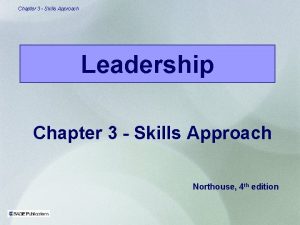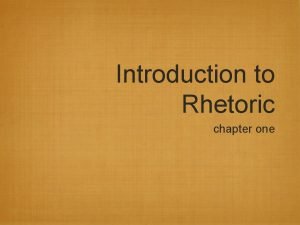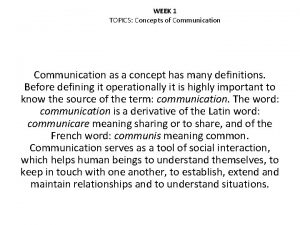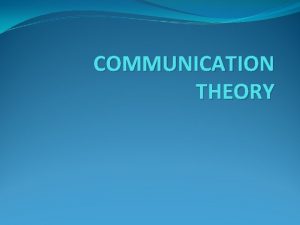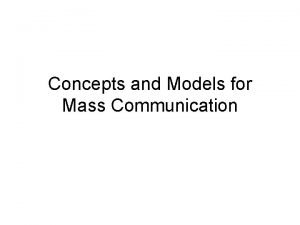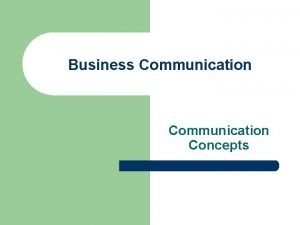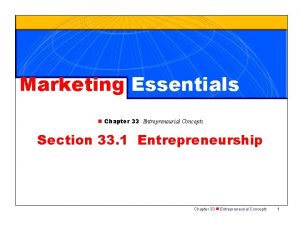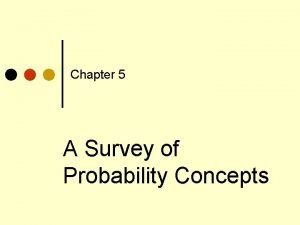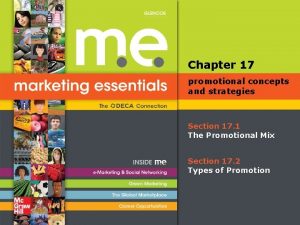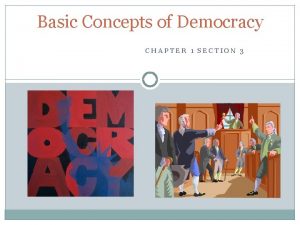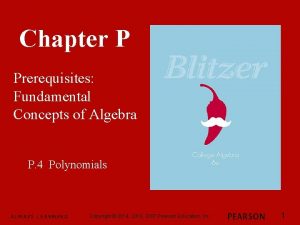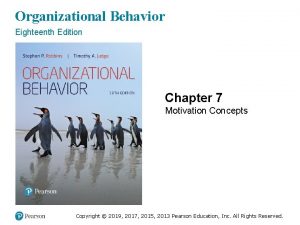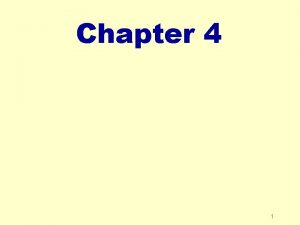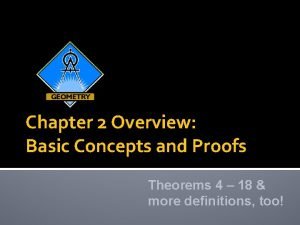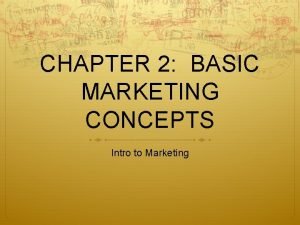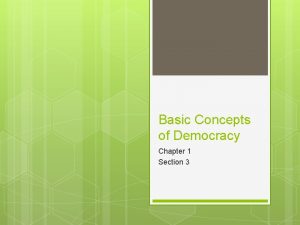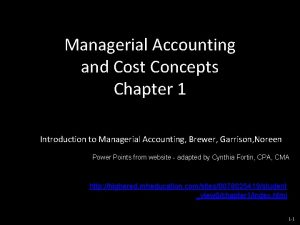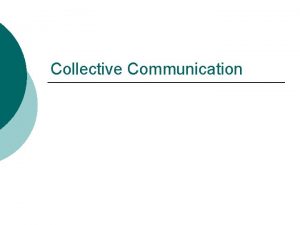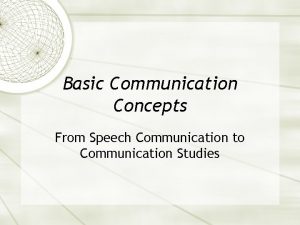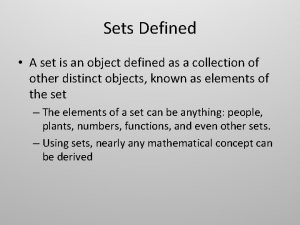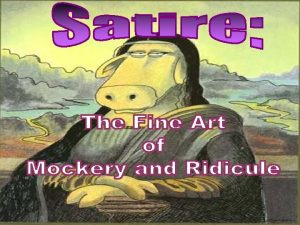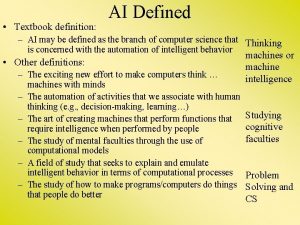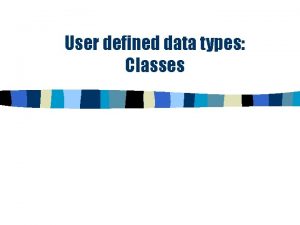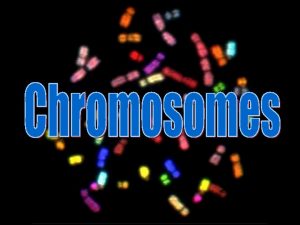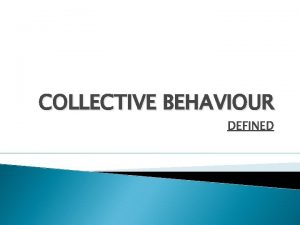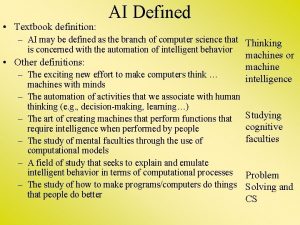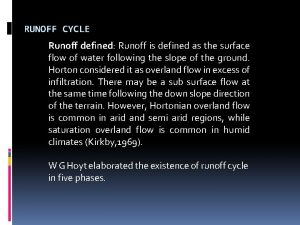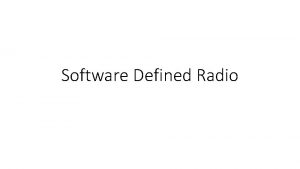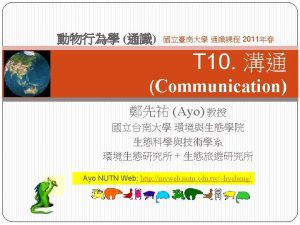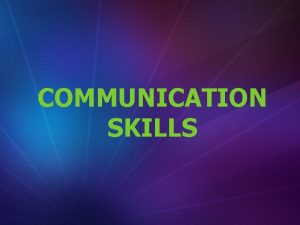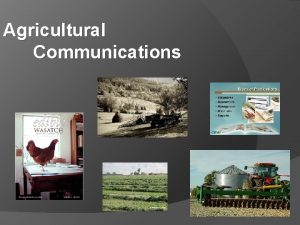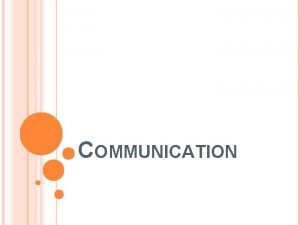Chapter 1 Communication Concepts Communication Defined l What

































- Slides: 33

Chapter 1 Communication Concepts

Communication Defined l What is communication? l …the process of sending and receiving messages l Shared understanding is the key to effective communication

Communication Process Model l Communication process model breaks down communication into parts Message Decodes Encodes Sender/ Receiver Decodes Receive r/ Sender Feedback Encodes


Communication Process Model l Sender: originates a communication message l Receiver: destination of the communication l Encoding: sender changes thoughts into symbols l Decoding: receiver assigns meaning to symbols

Communication Process Model l Message: idea, thought, feeling or opinion to be communicated (clear or unclear) l Channel: medium through which the message travels from sender to receiver l Feedback: receiver’s response to the message/indicates the message is seen, heard and understood

Communication Process Model 1. l l l Sender (Encoder) Initiates the communication If both good and bad news will be given, the good news should be given first If both a simple and a complex message will be given, the simple one should be given first

Communication Process Model 2. l Message Verbal (part of the message that is heard) and nonverbal (body language and the surrounding environment)

Communication Process Model 3. l Channel Means used to convey the message

Communication Process / Channel a. Immediate feedback b. Other party may not understand channels c. Other party may be reluctant channels Oral communication verbal

Communication Process / Channel d. Need to document the communication written channels e. Message should have detailed accuracy written channels f. Message must be delivered to many people written channels

Communication Process / Channel Types of channels within an organisation a. Downward Channels: passing information from superior to subordinate to; • give job instructions • bring about understanding of the job • provide information about procedures • provide feedback about performances of subordinates LOSS OF INFORMATION

Communication Process / Channel b. Upward Channels: provides subordinates • • to convey information to their superiors to; gain feedback and learn about problems that affect efficiency, evaluate employee attitudes and perceptions SUBORDINATES FEEL THEIR SUPERIORS ARE NOT THAT OPEN AND ENCOURAGING

Communication Process / Channel c. Lateral Channels: conveying information between • • individuals and units on the same hierarchical level for; the coordination of tasks sharing of information, problem solving conflict resolution This type of communication is persuasive and suggestive rather than directive or authoritative

Communication Process / Channel message d. Informal Channels: grapevine B message C Single-strand: Each person recieves information from one person and passes it on to one more Gossip: one individual passes the news to all others A A B C D

Communication Process / Channel d. Informal Channels: Probability: Information is passed on randomly Cluster: Channel members selectively choose their informal communication links COMMUNICATION BARRIERS IF THEY CARRY RUMOR, GOSSIP, INACCURATE INFORMATION

Communication Principles l Communication occurs within a context (when, where, why and with whom) – Chronological context: time a which communication occurs – Physical context: location or setting of your communication

Communication Principles – – – Functional context: purpose of the communication l Practical: job, apartment, health and safety l Social: establish connections, building ties l Decision-making: how to dress for the weather, where to live Relational context: person(s) with whom you communicate and your relationship Cultural context: race, ethnicity, gender, age, sexual preference, disabilities, etc.

Communication Principles l Communication is unavoidable – Try to not communicate – Intrapersonal: internal monologue that judges, comments, worries, dreams and analyzes.

Communication Principles l Communication occurs at different levels – No two relationships are alike – – Small talk: establish contact with others and build rapport Information talk: hobbies and interests, likes and dislikes, personal preferences

Communication Principles – Opinion talk: riskier than the other levels; you open yourself up to criticism and disagreements can lead into conflict – Feelings talk: most challenging because you expose parts of your inner self

Communication Principles l Communication requires ethical choices – Freedom of speech doesn’t mean you can say anything you please. – Words can nurture, resolve misunderstandings or create intimacy – Words can strain relationships, destroy trust or land you in jail – Plagiarism, falsify records, harassment, etc.

Communication Principles l Communication has its limitations – – Communication cannot solve all your interpersonal problems. Many other skills are needed (for ex. Flexibility, forgiveness, open to change). Other factors threaten stability of relationships Workplace relationships can be demanding.

Communication Barriers l Internal Noise – – – Occurs inside the sender and receiver Beliefs and values Faulty assumptions can lead to emotion Trigger or hot button words can evoke emotion Defensiveness

Communication Barriers l External Noise – – – Occurs outside the sender and receiver Can be easier to control than internal noise Includes technology

Communication Barriers l Semantic Noise – – – Occurs when the receiver doesn’t understand a word or gesture Can happen with different cultures Technicians using jargon with laypeople

Communication Barriers l Gaps – – – – Results from people being different Gender Age Ethnicity Race Status Sexual orientation Generation

Barriers to Communication / Problems caused by the sender l l l l The amount of information the individual has about the subject of the message Not much information Too much knowledge Indecission regarding how to present the information The order of the presentation Lack of familiarity with the audience Emotional conflict Lack of experience in speaking or writing

Barriers to Communication / Problems in transmission Illegible material as a result of poor typing, poor photocopying, poor handwriting l Poor acustics l Use of too many transmission links l Transmission of conflicting messages l

Barriers to Communication / Problems in reception The surrounding environment l Receiver’s physical condition l Receiver’s failure to pay attention to the message l – – Simultaneous receipt of two or more messages Receiver is bored

Barriers to Communication / Problems in receiver comprehension Receiver may not understand some of the words used l Personal interests l Emotional responses l

Dealing with communication barriers l l l Focus on the objective Unserstand the other party Be organized Seek feedback Know yourself

Communication and Technology l l l i. Pods Information at students’ convenience Need for computer literacy Less connected Need for balance
 It is a collection of well-defined objects.
It is a collection of well-defined objects. Leadership skills are defined in the chapter as
Leadership skills are defined in the chapter as How is rhetoric defined in this chapter?
How is rhetoric defined in this chapter? Concepts of communication
Concepts of communication Concepts of communication
Concepts of communication Concept of communication integration
Concept of communication integration Concepts in mass communication
Concepts in mass communication Business communication concepts
Business communication concepts Chapter 17 promotional concepts and strategies
Chapter 17 promotional concepts and strategies Chapter 33 entrepreneurial concepts
Chapter 33 entrepreneurial concepts Chapter 15 developing fraction concepts
Chapter 15 developing fraction concepts A survey of probability concepts chapter 5 solutions
A survey of probability concepts chapter 5 solutions Promotional concept
Promotional concept What are the five basic concepts of democracy
What are the five basic concepts of democracy Prerequisites fundamental concepts of algebra
Prerequisites fundamental concepts of algebra Chapter p prerequisites fundamental concepts of algebra
Chapter p prerequisites fundamental concepts of algebra Chapter p prerequisites fundamental concepts of algebra
Chapter p prerequisites fundamental concepts of algebra 1. part one—analyzing accounting concepts and procedures
1. part one—analyzing accounting concepts and procedures Reviewing concepts and vocabulary chapter 1
Reviewing concepts and vocabulary chapter 1 Chapter 1 activity basic concepts
Chapter 1 activity basic concepts Unit 2 criminal law and juvenile justice
Unit 2 criminal law and juvenile justice Chapter 7 organizational behavior
Chapter 7 organizational behavior Chapter r basic concepts of algebra answers
Chapter r basic concepts of algebra answers Sf4o lewis structure
Sf4o lewis structure Operating system concepts chapter 8 solutions
Operating system concepts chapter 8 solutions Operating system concepts chapter 5 solutions
Operating system concepts chapter 5 solutions Operating system concepts chapter 5 solutions
Operating system concepts chapter 5 solutions Chapter 4 accounting study guide
Chapter 4 accounting study guide Chapter 2 basic concepts and proofs answers
Chapter 2 basic concepts and proofs answers Basic marketing concepts
Basic marketing concepts Physics chapter 1 introduction and mathematical concepts
Physics chapter 1 introduction and mathematical concepts Chapter 1 section 3 basic concepts of democracy
Chapter 1 section 3 basic concepts of democracy A survey of probability concepts chapter 5 solutions
A survey of probability concepts chapter 5 solutions Relevant range managerial accounting
Relevant range managerial accounting

